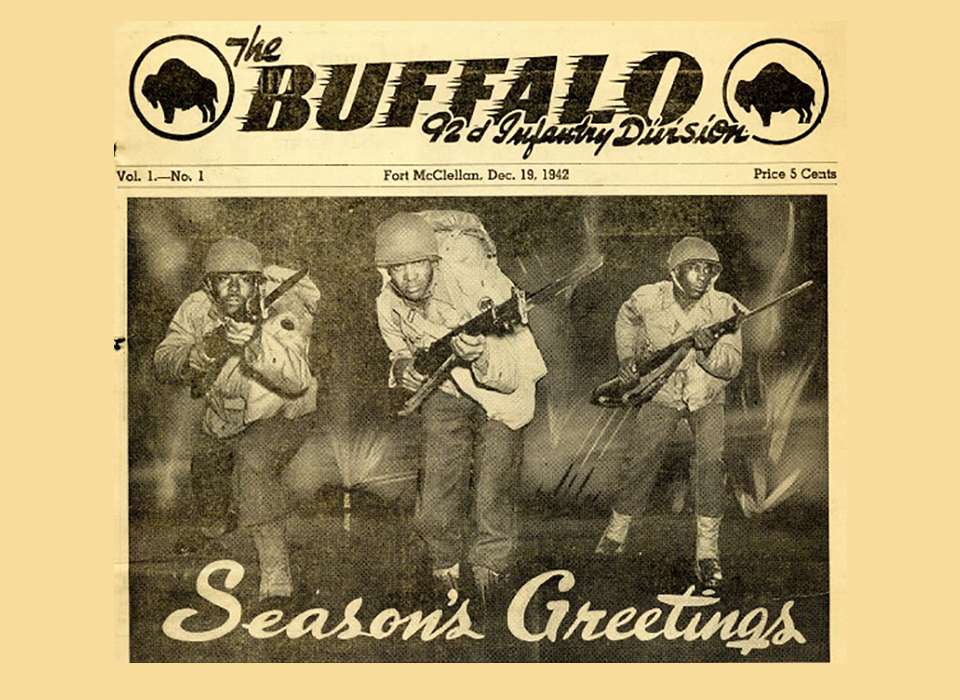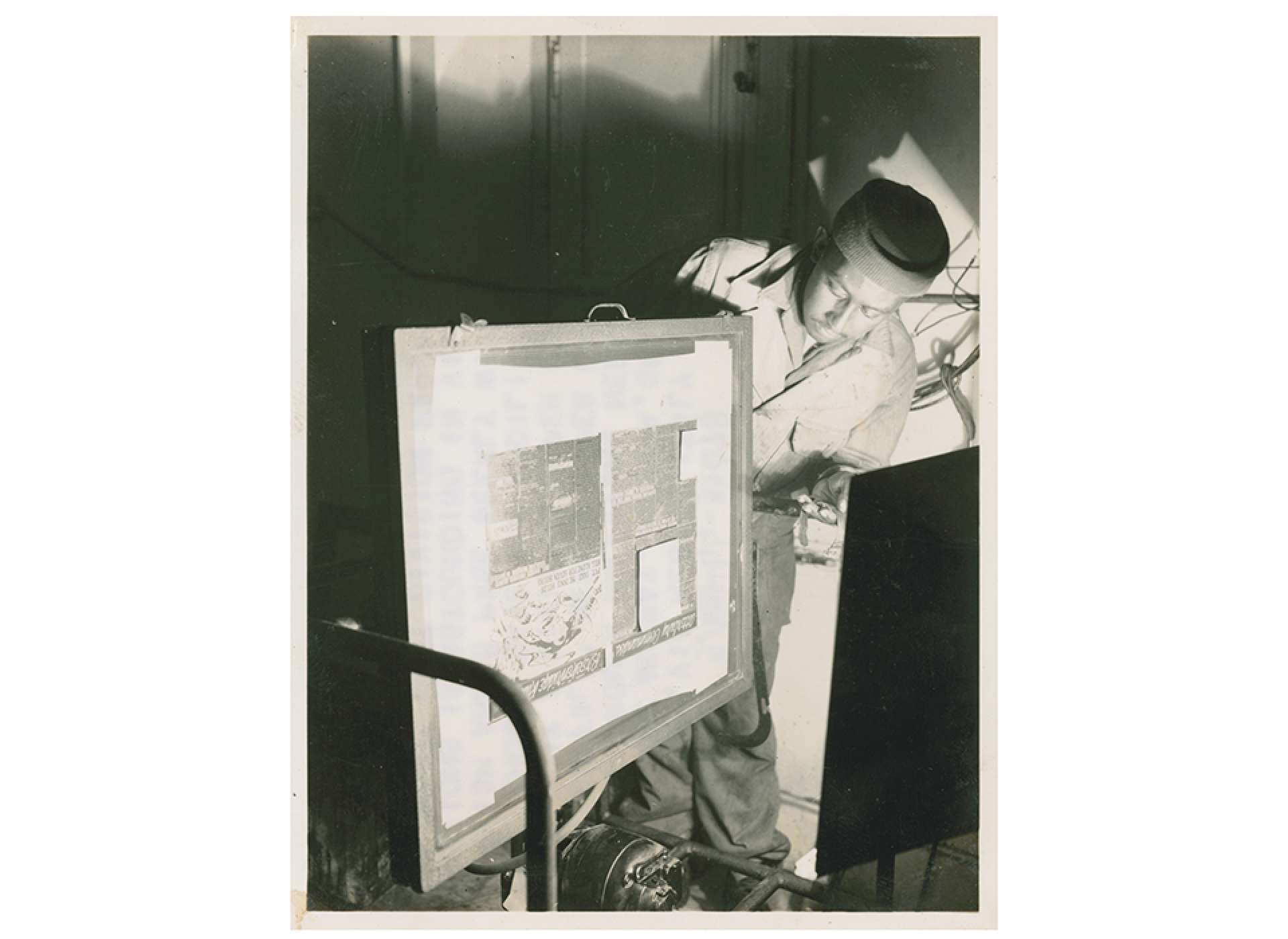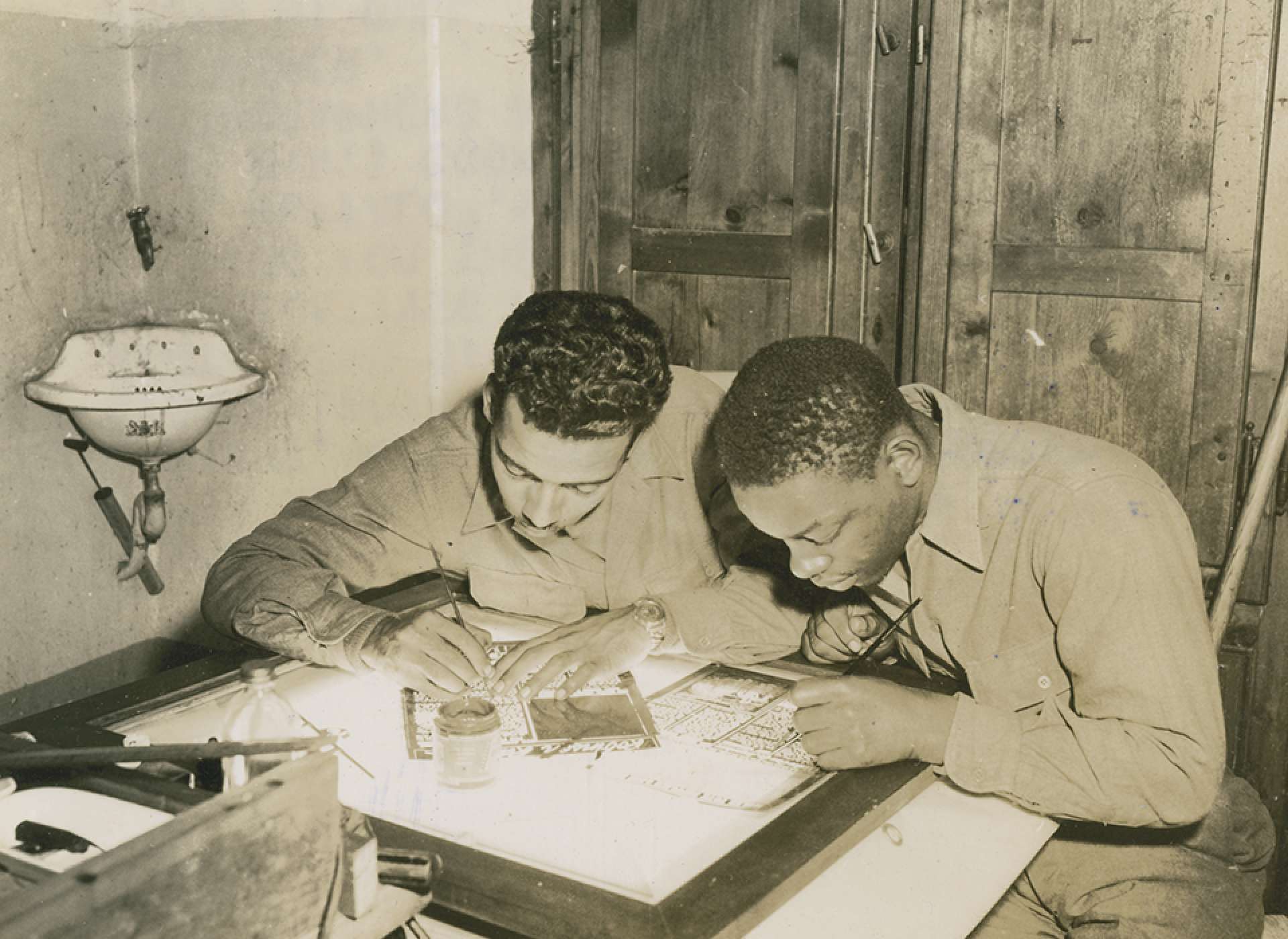Top Image: The front page of the 92nd Infantry Division’s first newspaper. The Buffalo Vol. 1 No. 1, December 19, 1942. Courtesy US Army Heritage and Education Center.
Between 1942 and 1945, the number of newspapers published by and for American servicemen exploded from less than 500 to nearly 4,000. Two of them belonged to the only all-Black divisions to see combat during the war, and one would quickly establish a reputation as one of the finest service publications in the US military.
The segregated 92nd Infantry Division, composed primarily of enlisted African American personnel and nicknamed the “Buffalo Soldiers,” was activated on October 15, 1942. Just two months later, the first issue of the division’s newspaper began circulating. Fittingly titled The Buffalo, the eight-page weekly aimed to keep the men informed about the progress of their training and carried a diverse selection of entertaining and educational columns, all for a nominal five cents. It ran for almost three years and published six volumes with more than 150 issues.
As the rapid growth of service papers might suggest, print journalism played a critical role in the war effort. Troops depended on newspapers to facilitate training, relieve boredom, and notify them of current events. Beyond disseminating news, these publications also enabled larger units like the 92nd Infantry to develop a shared sense of pride and purpose—an essential esprit de corps.
From its inception, The Buffalo assumed an important objective: It strived to advance the division’s mission of becoming a “unified fighting force, proficient in the use of its weapons and imbued with the desire to close with and destroy the enemy.” If the unit’s eventual combat record is any indication, the paper fulfilled its purpose, though it did not come without complications.
In its earliest stages, The Buffalo encountered some unique logistical challenges. News gathering and distribution proved difficult, as various components of the 92nd Infantry were geographically scattered across four different military installations. Headquarters, the hub of paper operations, resided at Fort McClellan in Alabama, while three regimental combat teams trained elsewhere: the 365th at Camp Atterbury in Indiana, the 370th at Camp Breckenridge, Kentucky, and the 371st at Camp Robinson in Arkansas.
As a result, the staff organized the Buffalo Press Bureau. The Bureau oversaw operations and appointed correspondents, editorialists, and photographers to cover training activities for each combat team. The units submitted weekly news and images to the editorial office, where the main staffers wrote headlines and designed layouts before sending the copy to The Anniston Times in Alabama for final printing. Two of the encampments even established onsite laboratories to professionally develop photographs.
In its effort to “become a part of a first-class fighting machine,” The Buffalo offered an enjoyable, inclusive blend of training tips, news, human interest stories, and entertainment. While it naturally evolved alongside the division, the first volume introduced some popular features and columns that would become staples in the course of The Buffalo’s life.
Readers turned to the “Chaplain’s Corner” for moral and spiritually-driven guidance and flipped to “Buffalo Bull” to hear from the wisecracking, self-proclaimed “super-snooper” of the division, who anonymously dished out “the inside slants on all the fellows.” They learned about must-read books in Charles Cranford’s “After Hours” column, sought advice from “Oxford Shorty,” and followed humorous stories in “At Ease!” The sports page remained an integral component from the outset, tracking the results of widely followed recreational games and competitive tournaments in football, baseball, basketball, boxing, and track.
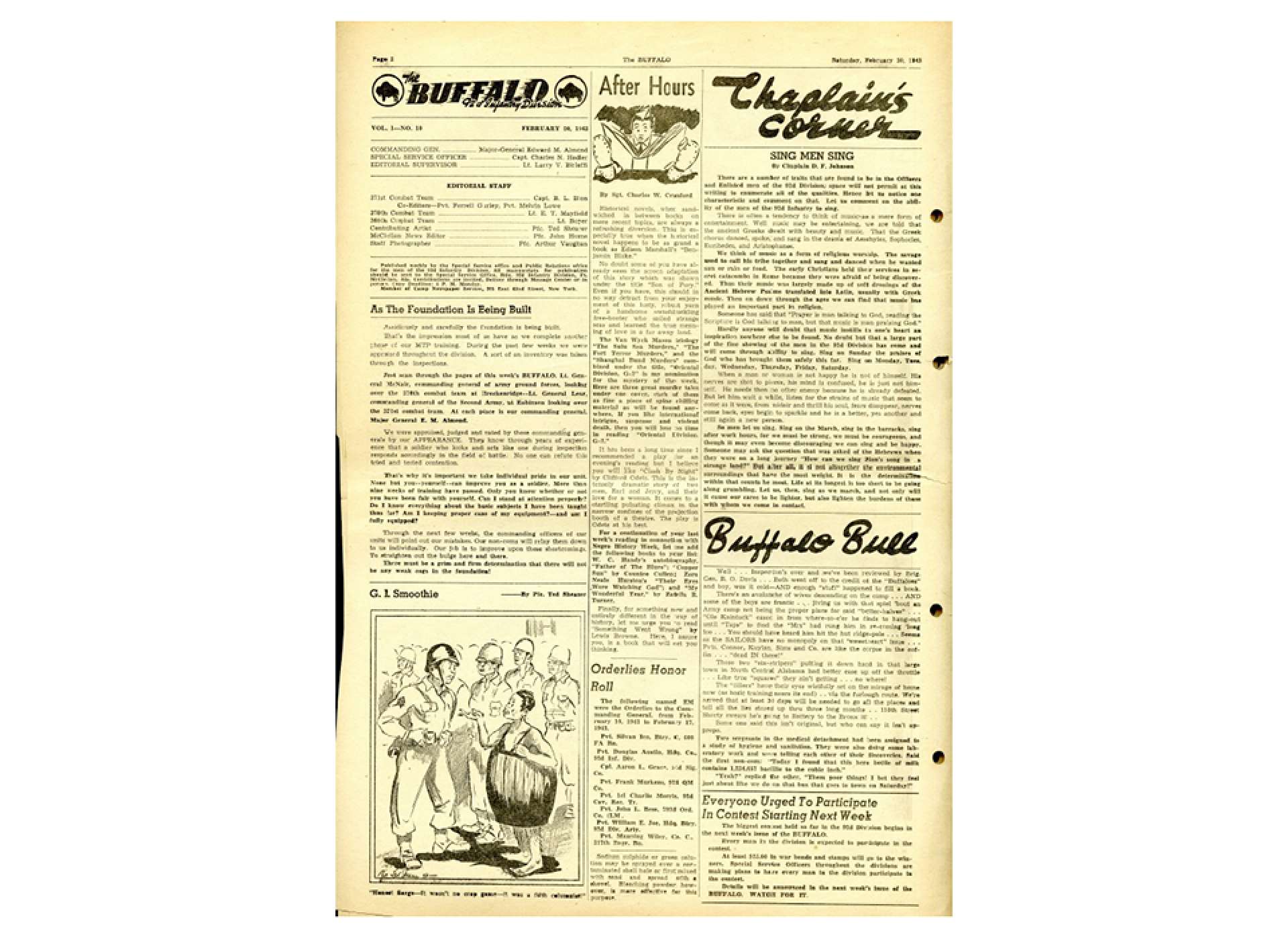
An example of the paper’s editorial page. The Buffalo, Vol. 1 No. 10, February 20, 1943. Courtesy US Army Heritage and Education Center.
To encourage participation and collaboration, the paper also hosted a number of division-wide contests with cash prizes. It invited members to propose names for the division’s “honest-to-goodness live bison” mascot (ultimately named Buffalo Bill), engage in weekly quiz bowls, suggest clever titles for headlines, and submit essays on a range of different topics. It also welcomed content recommendations and contributions from the soldiers and organized philanthropic fundraisers.
One of The Buffalo’s crowning achievements came relatively early in its career. Just a month after its debut, the paper ranked as a top contender in a field of 350 entries of Army, Navy, Marine Corps, and Coast Guard publications from all over the globe. The friendly competition was hosted by the Camp Newspaper Service in New York and judged by elite editorialists of acclaimed newspapers.
The 92nd was the only infantry combat division to finish in the top bracket and win a CNS Achievement Award. The paper’s triumph generated considerable interest in military circles as well as the national press. Units everywhere requested publication exchanges and even The New York Times asked to be put on the weekly mailing list.
The paper did not only win the praise of noted military figures, renowned journalists, and the CNS, but it also gained a sizable following in the civilian sector. For the price of postage, many soldiers in the 92nd Infantry sent copies home to friends and family members who, in turn, passed them on to other interested readers. Neighbors borrowed issues, students brought them to class, and healthcare professionals placed copies in waiting rooms. One Mexican woman living in Nogales even wrote in to say that she read The Buffalo each week to help improve her English.
The first volume of the paper drew to a close when the constituent parts of the 92nd Infantry all relocated to Fort Huachuca in the remote southwestern desert of Arizona. “Practically a city in itself,” the fort served as the training grounds for the largest concentration of Black soldiers during the war. There, the entire division continued training until it deployed to join the Fifth Army in Italy in September 1944. This transition marked the beginning of the “bigger and better BUFFALO” that now included an additional four pages written by the Post Station Service Command (a short-lived segment).
For the most part, the general structure of the paper remained the same. Familiar columns still ran and each arm of the division continued to have a dedicated page for its own members. Some new pieces entered the mix, like an occasional Spanish lesson to help soldiers planning to visit nearby Mexico, or an “honor roll” that spotlighted units with the least amount of venereal disease cases or the fewest number of AWOL soldiers.
The content also grew to regularly include stories about the two Black Women’s Army Auxiliary Corps companies that shared Fort Huachuca, especially as men in the 92nd Infantry proved “keenly interested in their ‘sister soldiers.'”
Few features in The Buffalo stirred up more buzz than the original cartoons that depicted life in the 92nd Infantry Division. In the paper’s first issue, the editors called attention to 23-year-old, award-winning artist Thaddeus “Ted” Shearer whose cartoons like “Around Harlem” had appeared in several distinguished magazines before he joined the Army.
One of the longest-serving staff members, Shearer illustrated The Buffalo and contributed cartoons from the first issue to the last. After the war he would go on to create the world-famous comic “Quincy,” which was one of the earliest to feature an African American as the main character.
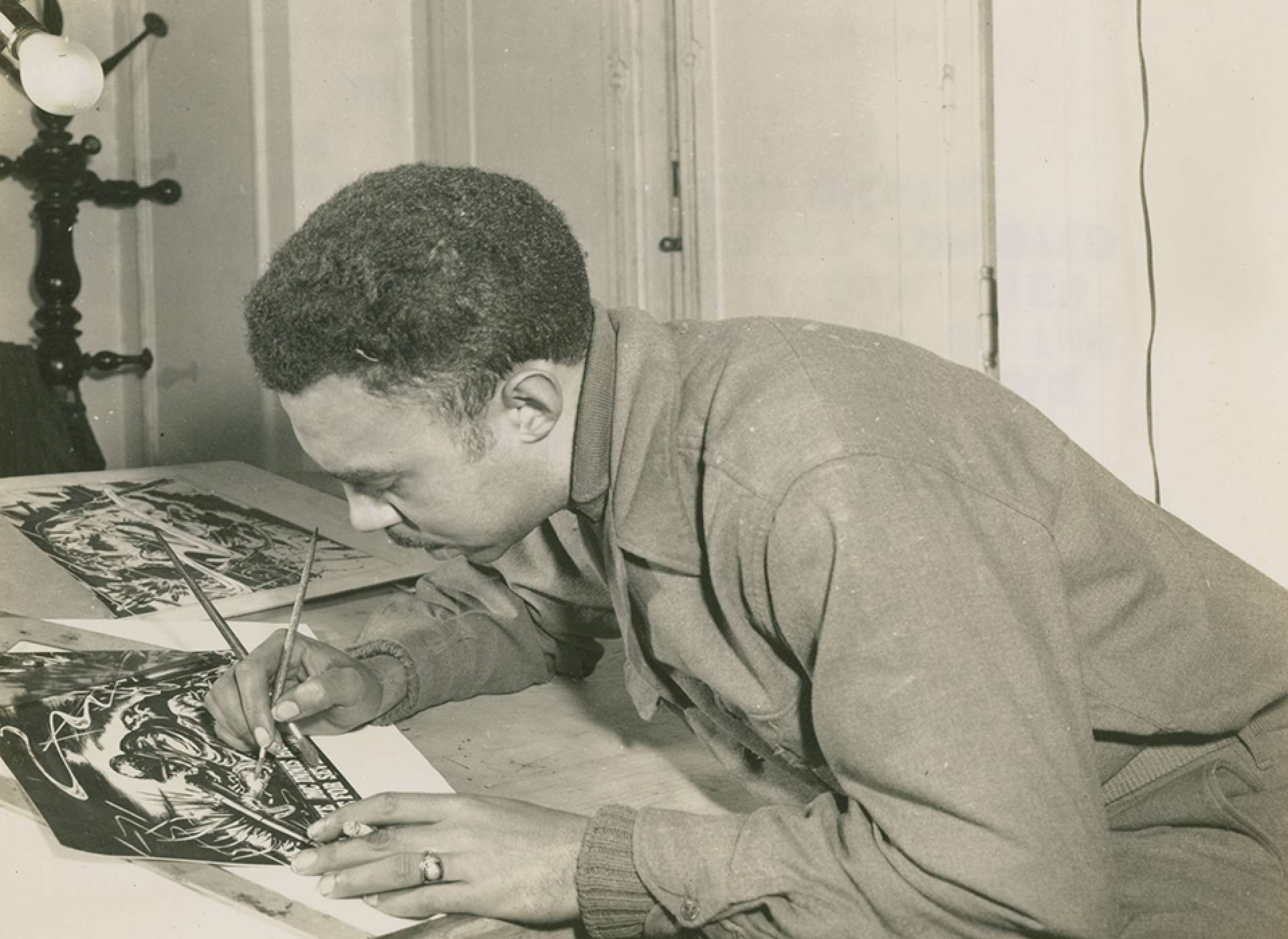
Renowned artist Ted Shearer hard at work designing new illustrations for The Buffalo. The National WWII Museum, Gift in Memory of William F. Caddell, Sr., 2007.048.281.
The first volume of The Buffalo witnessed the introduction of Shearer’s “G. I. Smoothie,” a single-panel cartoon that frequently placed a suave and silver-tongued Buffalo Soldier in comical situations. At Fort Huachuca, he launched a new fan-favorite called “Strechin’ a-Point,” which was a thematic tableau that satirized life in the Army and included subjects such as bivouacking, maneuvers, furlough, going to service clubs, and dating military women.
In July 1943, a new artist joined the team and took the division by storm. Ray Henry quickly became an esteemed cartoonist responsible for numerous new comics, including “The Home Front,” “On the Post,” “In the Field,” and “On Pass.” Henry’s beloved “Buffalo Billie” became a mainstay of the paper, as did his “Wacky Women.” The former was a more ribald version of Shearer’s “Smoothie” and the latter a suggestive cartoon that typically foregrounded naïve, scantily clad WAAC members.
Though the troops appreciated humorous cartoons, the artists endeavored to employ their talents in far more important ways, like to reinforce training. Shearer designed a series of drawings that asked soldiers to identify potentially deadly mistakes in imaginary wartime scenarios. Similarly, Henry created a multi-panel comic that juxtaposed the sensible actions and outcomes of the fictitious Private Smart against those of his careless counterpart, Private Sapp, to illustrate the importance of following protocol. The pair used their artistic abilities to support the paper’s mission and thereby prepare their fellow GIs for inevitable combat.
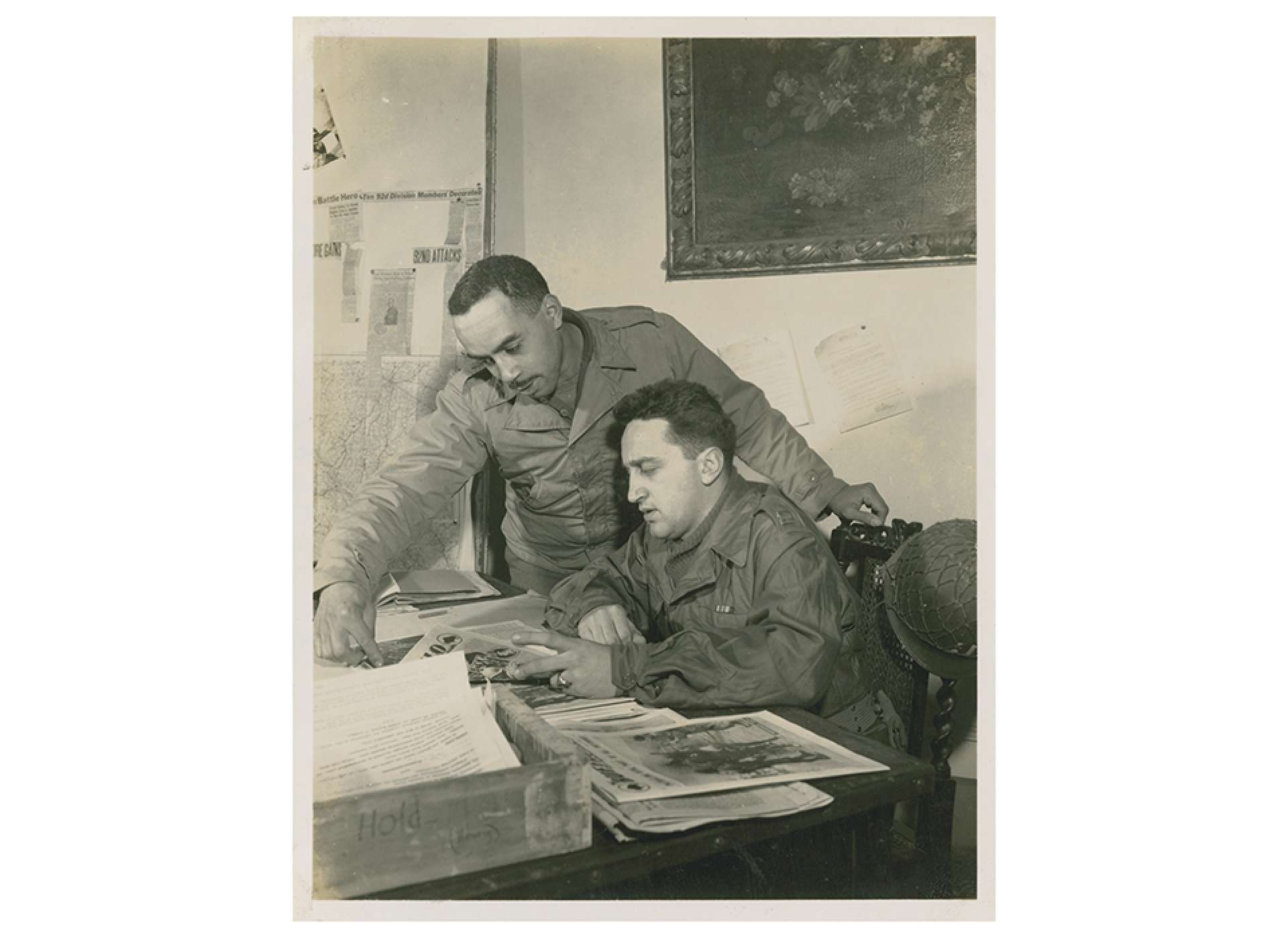
Cartoonist Ray Henry and Editorial Supervisor Larry Birleffi review the layout for the next issue of the paper. The National WWII Museum, Gift in Memory of William F. Caddell, Sr., 2007.048.493.
The Buffalo staff celebrated another milestone in August 1944 when the paper obtained its own printing press, typesetter, and engraving system. Instead of relying on civilian publishing companies as it had done in the past, the team could now deliver a “combat-streamlined BUFFALO” independently, which would be important in the following months.
In September, the 92nd Infantry sailed for the Mediterranean to participate in heavy combat. Even in a foreign land dominated by a fierce enemy, the staff members maintained their almost impossibly high standards. They often wrestled “into the wee hours of the morning” with their own printing press to meet deadlines. That a combat division could publish an eight-page weekly with illustrations in those conditions is a testament to both its resolve and capabilities, as most overseas combat units were often limited to single-page mimeographs with simple designs.
-

One of the first staffers trained to use the printing press, Roscoe Murray prepares a printing plate from a halftone negative for The Buffalo. The National WWII Museum, Gift in Memory of William F. Caddell, Sr., 2007.048.545.
-

Pictured left to right, photographers Verdun Cook and Robert Stokely opaque negatives to make plates for the weekly paper. The National WWII Museum, Gift in Memory of William F. Caddell, Sr., 2007.048.018.
Despite the division’s new reality, namely combat operations in Italy, little changed in regards to The Buffalo’s tone. It was business as usual and the paper maintained a balance that tempered serious news with lighthearted fun. News of the division’s accomplishments on the frontlines featured prominently, as did personnel promotions and commendations, and the crusade against venereal disease remained as prevalent as ever.
Under the supervision of a skeleton staff, the final issue of The Buffalo was published in northern Italy on October 29, 1945, a month before the division’s inactivation. As in other recent issues, it carried articles to assist with the transition back to civilian life, encouraged soldiers to capitalize on opportunities to obtain an education, and advised the more entrepreneurially-minded on how to start a business.
For nearly 35 consecutive months, the staff of The Buffalo upheld its promise to deliver the news to men of the 92nd Infantry Division, regardless of circumstances. It repeatedly surmounted obstacles, like the time the division went on maneuvers and it had to rig up a makeshift office in an abandoned PRO station. The copy had to be sent almost 200 miles away for printing. The editorial team worked tirelessly to provide a publication that would bolster fortitude, inspire confidence, promote solidarity, and keep morale high.
From the beginning, the staff knew that the paper would not only serve as the official organ for the 92nd Infantry but would also be “an informal record of our experiences with a great organization.” And they were right. Today, The Buffalo remains a rich, invaluable primary source that chronicles the exploits of the only Black division to fight in the European theater, from its activation through its dissolution.
Unlike any official unit history, The Buffalo offers a unique window into the mindset and experiences of a marginalized group that fought injustices at home and threats to freedom abroad. Throughout the paper, however, issues of racial discrimination largely disappeared behind a broader message of unity and triumph over evil.
Ultimately, the publication itself became a symbol of the very principles that the 92nd Infantry fought to protect. For the writers of The Buffalo the paper was “evidence that we have our own ideas, and the intelligence and the humor and the freedom to express them,” and with that contribution, they solidified themselves as “delegates of freedom.”
Chase Tomlin
Chase Tomlin is an Associate Curator at The National WWII Museum.
Cite this article:
MLA Citation:
APA Citation:
Chicago Style Citation:
